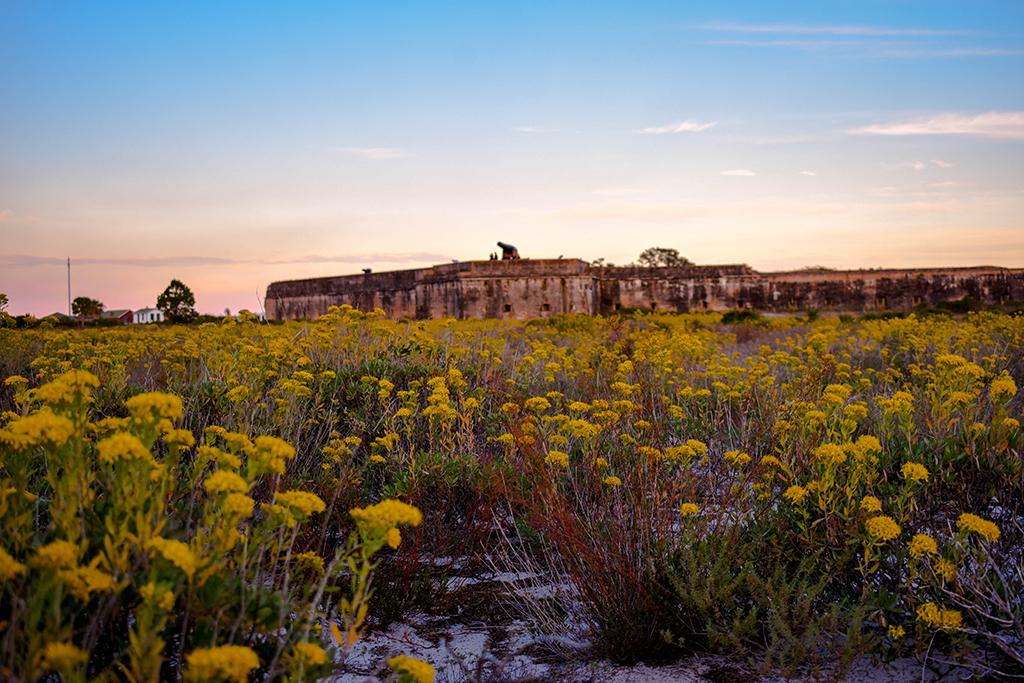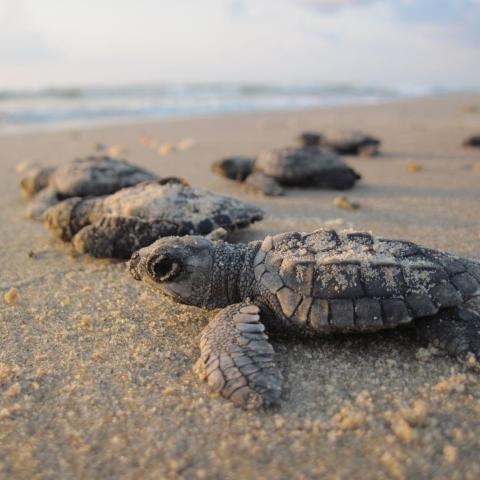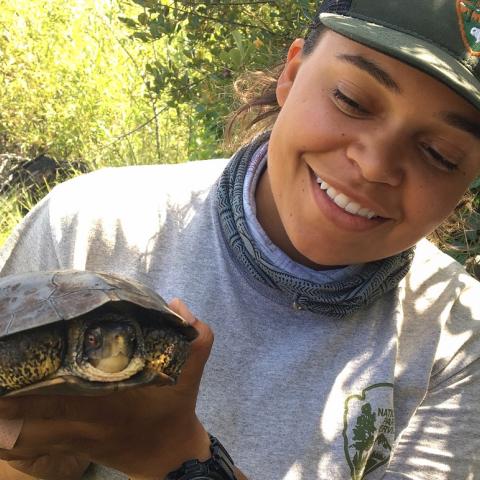
The view along Grinnell Glacier Trail, Glacier National Park / Rebecca Latson
Here we are, Travelers, at Quiz And Trivia #13. Ah yes, lucky number 13. And, just how lucky are you? How much do you really know about these national parks and protected lands? Test your knowledge first, before checking the answers at the end of the page. Then read a little bit of trivia with which to impress friends and family.
1. A visit to Glacier National Park in Montana will put you within sight of such glaciers as Sperry, Grinnell, Jackson, Salamander, and Piegan glaciers. What’s the difference between glacier ice and seasonal snow?
a) seasonal snow is much whiter and cleaner
b) glacier ice is frequently covered in rocks and dirt
c) both of the above
d) neither of the above
2. The landscape of Theodore Roosevelt National Park shows evidence of a volcanic past in the form of ___.
a) ancient cinder cones
b) bentonite clay deposits
c) ancient basalt flows
d) volcanic tuff

Faces in the fog, Mount Rushmore National Memorial / National Park Service
3. Mount Rushmore National Memorial sculptor Gutzon Borglum selected the four presidents we see on the mountainside to represent major events in the history of the United States. Can you match the event with the president?
a) Washington 1 growth
b) Lincoln 2 development
c) Roosevelt 3 preservation
d) Jefferson 4 birth
4. What was the first cave (or caves) to be designated as a national park?
a) Wind Cave
b) Jewel Cave
c) Mammoth Cave
5. Rocky Mountain National Park is filled with different species of trees, including the Rocky Mountain maple, which is the only member of the maple family that can _____.
a) germinate in cold weather
b) live to 1,000 years
c) deepen each lobe to the point where it separates into multiple leaves
d) be used for the making of musical instruments because of the way it carries sound waves

Fort Pickens at sunset, Gulf Islands National Seashore / National Park Service
6. While investigating Fort Pickens at Gulf Islands National Seashore, you might make an armadillo sighting. True or False: armadillos can inflate their intestines to act as a life jacket while crossing water.
a) True
b) False

A view from the top of Watchman Peak, Crater Lake National Park / National Park Service
7. Crater Lake National Park is the only place in the world to find the Mazama newt. True or False: Newts are not salamanders.
a) True
b) False
8. The most common snake found in Acadia National Park is the ______.
a) garter snake
b) ring-necked snake
c) red-bellied snake
d) timber rattlesnake

Yosemite Falls, Yosemite National Park / Alberto Cruz
9. True or False: Yosemite National Park’s Yosemite Falls, one of the world’s tallest waterfalls, is made up of three separate waterfalls.
a) True
b) False
10. The highest point in Great Smoky Mountains National Park is at ____.
a) Mount Guyot
b) Mount Buckley
c) Mount Chapman
d) Clingmans Dome
And now for a little bit of trivia

November sunset at Portage Lakefront and Riverwalk, Indiana Dunes National Park / National Park Service
As you walk along the sands at Indiana Dunes National Park, you may notice dark-colored streaks among the lighter quartz sand grains. Those dark grains are, in part, a naturally magnetic mineral called – you guessed it – magnetite. If you place a small fridge magnet down near those dark grains of magnetite, you can see those grains leap up and attach themselves to the magnet.
Have you ever “taken the waters” at Hot Springs National Park in Arkansas? These warm-water springs bubbling up from beneath the surface get heated up via a different method than the hot springs you’ll see in Yellowstone or Lassen Volcanic national parks, where the water is heated up by coming into contact with magma (molten rock). “The water here has no volcanic component at all and it's heated completely through conduction or contact with parent rock material that's very deep in the earth… plunging to a depth of around seven, maybe eight thousand feet before it makes its way back to the surface ... And the rate at which the temperature heats up with depth is predictable. Geologists call this a geothermal gradient. The water … comes out of the ground at about an average temperature of 140 degrees Fahrenheit or 61 degrees Centigrade. The reason it has no odor and doesn't have a taste is that there's a general lack of sulfur compounds that are common with volcanic heat sources. This is the only place in the [National Park] System that offers geothermal water as a potable water supply.”

Weeping Wall in the summer, Glacier National Park / Rebecca Latson
Staying on the subject of water, if you’ve ever driven the spectacular Going-to-the-Sun road in Glacier National Park, you’ve driven past (or through, depending upon the amount of water) Weeping Wall, a series of waterfalls gushing or trickling out from the rock wall beside the road. This entire wall of waterfalls is actually “a remnant of the construction of Going-to-the-Sun Road. As engineers carved through the rock, they created a cliff. Water from springs and melting snows above pour over and onto the road surface below. Special drains were designed in the road to allow the bulk of the water to pass below the pavement.”
Quiz Answers
1c
Most of the time, glaciers are covered in seasonal snow, which makes it difficult to see the actual glacier. However, you can tell when you are looking at the actual glacier as opposed to the snow by the fact that seasonal snow, which melts away by late August – early September, is much cleaner and whiter. Glacier ice is dirty since it picks up rocks, sediment, trees and whatever else is in its path. To learn more about Glacier’s glaciers, click here.
2b
Ok, so while there are no volcanoes at Theodore Roosevelt National Park, the land there displays evidence of past volcanic eruptions that occurred in South Dakota, Montana, and Idaho. These eruptions produced large amounts of ash, which spread via wind and water out onto what is now the landscape of this national park. This ash eventually weathered into a soft blue-gray clay called bentonite, and you can see blue bands of bentonite along the Little Missouri River. You might also see what look like flows of bentonite down the side of a hill. This is because bentonite can absorb a great deal of water, which makes it mucky and liquid enough to flow down from between layers of other sediment.
3 a4, b3, c2, d1
“Because of his importance, Borglum chose Washington to be the most prominent figure on the mountain and represent the birth of the United States.” Gutzon Borglum chose Jefferson to represent the growth of the United States, Roosevelt to represent the development of the United States, and Lincoln to represent the preservation of the United States. To read more about these presidents and why Borglum chose them, click here.
4a
Named for the wind that blows in and out of the small natural entrance due to barometric pressure, Wind Cave was established January 9, 1903, becoming the first cave to be designated as a national park. As of 2019, Wind Cave National Park has 150 miles of surveyed passages. To read more about barometric pressure and the wind at wind cave, click here.
5c
“The leaves (of the Rocky Mountain maple) usually will have three deep lobes. Rocky Mountain maple has the ability to deepen each lobe to the point where it separates into multiple leaves, creating a compound leaf from a simple leaf formation. It's the only member of the maple family that can do this.”
6a True
Not only can the nine-banded armadillo (the only armadillo that lives in the U.S.) inflate its intestines to make a water crossing, but it can hold its breath for up to six minutes while underwater.
7b False
Newts are a type of salamander that, when adults, live a semi-aquatic to totally aquatic life. Not all salamanders are newts, however, since salamanders mainly live a terrestrial life, except when they are breeding and laying eggs. Newts also have webbed feet and a tail shaped like a paddle to more easily maneuver within and under the water.
8a
“Acadia has only seven known species of reptiles. This includes five snakes and two turtles. Fortunately for visitors, none of the snakes are venomous. Probably the most common and best known is the garter snake (Thamnophis sirtalis). These cold-blooded animals need to warm their bodies up in the sun, especially on cool mornings, so be courteous and don't disturb them.”
9a True
“Yosemite Falls, one of the world's tallest, is actually made up of three separate falls: Upper Yosemite Fall (1,430 feet), the middle cascades (675 feet), and Lower Yosemite Fall (320 feet).” It’s also one of the most common places to see a rainbow at night. Called a moonbow, this beautiful feature occurs when the moon is full and bright enough to shine on a waterfall’s mist and create a rainbow.
10d
Clingmans Dome, with an elevation of 6,643 feet above sea level, is the highest point in Great Smoky Mountains National Park. To read more about Clingmans Dome, click here.
References
In addition to the information found at each NPS.gov national park website page, I also used the following as references:
Emily Hoff & Maygen Keller, Scenic Science of The National Parks, Ten Speed Press, 2020
https://mnfi.anr.msu.edu/communities/description/10699/Open-Dunes
https://www.nps.gov/hosp/learn/education/upload/followthewater_final.pdf
https://www.nps.gov/hosp/learn/photosmultimedia/why-water-hot.htm
https://www.nps.gov/media/video/view.htm?id=BAC596DF-155D-451F-67E0AAB0104603A0
https://www.nps.gov/media/video/view.htm?id=6AA5A96C-B226-0A41-AEDF5A69B74822E9
https://www.nps.gov/romo/learn/nature/shrubs.htm
https://www.nps.gov/yose/planyourvisit/waterfalls.htm
https://www.doi.gov/blog/9-things-you-didnt-know-about-yosemite-national-park
https://www.tripsavvy.com/yosemite-falls-overview-1479327
https://www.doi.gov/blog/12-things-you-didnt-know-about-crater-lake-national-park
https://www.mnn.com/earth-matters/animals/blogs/what-difference-between-salamander-and-newt
https://www.nationalparked.com/wind-cave
https://www.cnn.com/2013/10/01/us/mount-rushmore-national-memorial-fast-facts/index.html
https://www.nps.gov/moru/learn/historyculture/why-these-four-presidents.htm




 Support Essential Coverage of Essential Places
Support Essential Coverage of Essential Places






